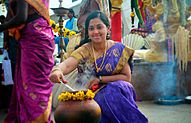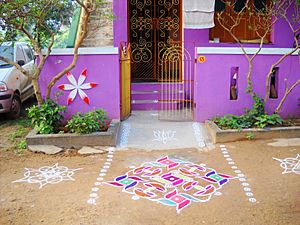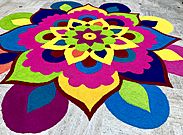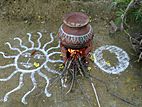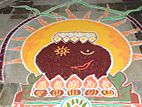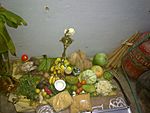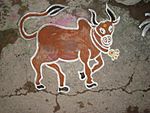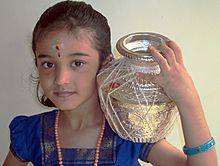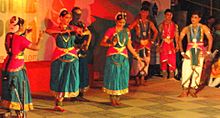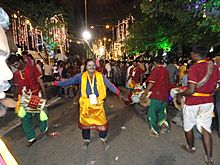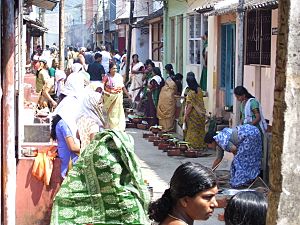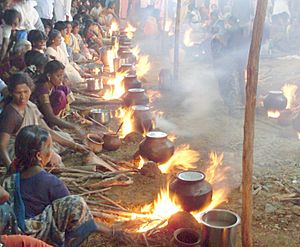Pongal (festival) facts for kids
Quick facts for kids Pongal |
|
|---|---|
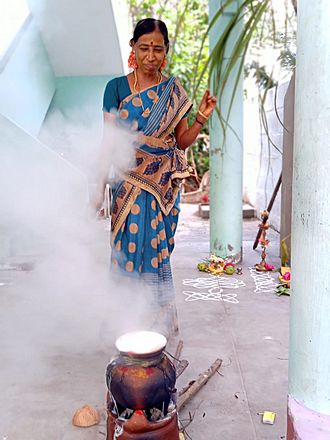
Pongal dish cooked for the occasion of the festival.
|
|
| Observed by | particularly Tamil people in India, Sri Lanka,Malaysia, United States, Indonesia, Mauritius, Singapore, UK, South Africa, Canada, Australia, |
| Type | Hindu festival |
| Significance | Harvest festival. Thanking the Sun God for agricultural abundance 4 days long |
| Celebrations | Pongal dish, decorations, flour dishes, home coming, prayers, processions, gift giving |
| Date | First day of the 10th month of Tai (Tamil calendar) |
| Frequency | Annual |
| Related to | Makar Sankranti, Magh Bihu, Uttarayana, Maghi, Maghe Sankranti, Shakrain |
Pongal (பொங்கல்) is a special harvest festival. It is also called Tai Pongal (தைப்பொங்கல்). People from the Tamil community in India and Sri Lanka celebrate it. This Hindu festival happens at the start of the month Tai in the Tamil calendar. This is usually around January 14th each year.
Pongal is a way to thank the Hindu sun god, Surya. It is similar to other harvest festivals across India, like Makar Sankranti. The festival usually lasts for three or four days. These days are called Bhogi Pongal, Surya Pongal, and Mattu Pongal. Some Tamils also celebrate a fourth day called Kanum Pongal.
This festival marks the end of winter. It also celebrates the sun starting its journey north. The word "Pongal" means "to boil" or "overflow." This refers to a special dish made during the festival. It is cooked with fresh rice, milk, and raw sugar. This dish is first offered to the gods. Then, it is shared with family and friends.
During Pongal, people decorate their homes. They make beautiful designs on the floor called kolam. They also offer prayers and exchange gifts. It is a time for families and friends to come together.
Pongal is very important for Tamil people. It is celebrated in many parts of India. These include Tamil Nadu, Karnataka, Kerala, Andhra Pradesh, Telangana, and Puducherry. It is also a big festival in Sri Lanka. Tamils living in other countries also celebrate it. These places include Malaysia, Mauritius, South Africa, Singapore, United States, United Kingdom, Canada, and the Gulf countries.
Contents
What Does Pongal Mean?
The word Tai (தை) is the name of the tenth month in the Tamil calendar. Pongal comes from the word pongu. This means "boiling over" or "overflowing." Pongal is also the name of the sweet rice dish. This dish is eaten during the festival.
The main idea of Pongal is to thank the Sun god. It also thanks nature, farm animals, and people who help with farming. An old writing from the Viraraghava temple mentions the Pongal festival. This temple is dedicated to Vishnu. The writing is from the time of the Chola king Kulottunga I (1070–1122 CE). It talks about land given to the temple for Pongal celebrations. An old text from the 9th century also mentions the festival.
The special Pongal dish has been made for a long time. It has been around since at least the Chola period. Old temple writings describe how to make it. These recipes are very similar to how Pongal is made today. The dish was often given out for free. This happened in temples in Tamil, Karnataka, and Andhra Pradesh. It was given to pilgrims and as festival food.
The Special Pongal Dish
Making the "pongal" dish is the most important part of the festival. It uses fresh rice from the harvest. The rice is boiled in milk and raw cane sugar (jaggery). Sometimes, other tasty things are added. These include cardamom, raisins, green gram (split), and cashew nuts. Coconut and ghee (clarified butter) are also used.
Besides the sweet Pongal, people also make salty or savory versions. In some places, women cook together. They bring their pots to a town center or temple. They cook in the sunlight, usually outside. This is because the dish is for the Sun god, Surya. Friends and family are invited. A common greeting is, "Has the rice boiled?"
The cooking pot is often a clay pot. It might be decorated with leaves or flowers. Sometimes, a piece of turmeric root is tied to it. The pot might also have kolam patterns on it. The dish is cooked at home or at community gatherings. It is a special meal for everyone. It is first offered to the gods. Sometimes, it is offered to cows too. Then, it is shared with friends and family. Temples often have free kitchens. Volunteers prepare food for everyone who gathers. This tradition helps people feel closer to each other.
The Pongal dish and how it's made are full of meaning. It celebrates the harvest. Cooking the dish turns farm gifts into food for gods and people. It marks the end of winter and the start of the sun's journey north. When the dish "boils over," it means good luck and plenty.
Days of the Pongal Festival
The festival lasts for three or four days in Tamil Nadu. In cities or for Tamils living outside India, it might be one or two days.
Bhogi Pongal: The First Day
Pongal starts with Bhogi Pongal. This is the last day of the Tamil month Marghazi. On this day, people throw away old things. They celebrate having new things. People gather and light bonfires. They burn piles of old items. Homes are cleaned, painted, and decorated. In villages, the horns of oxen and buffaloes are painted. People wear new clothes. Prayers are offered to Indra, the god of rain. People thank him and hope for lots of rain in the coming year.
Bhogi is also celebrated in Karnataka and Andhra Pradesh. There is a ceremony called Bhogi Pallu. Harvest fruits like regi pallu and sugarcane are collected. Flowers are also gathered. Sometimes, money is mixed with treats. This mix is poured over children. The children then collect the money and sweet fruits.
Surya Pongal: Honoring the Sun God
Surya Pongal is the second and main day of the festival. It is for the Hindu god Surya, the Sun god. This is the first day of the Tamil month Tai. It happens at the same time as Makara Sankranthi. This is a winter harvest festival celebrated all over India. This day marks the start of the Uttarayana. This is when the sun moves into the Capricorn sign.
Families and friends celebrate together. The Pongal dish is cooked in a traditional clay pot. This is done outdoors, where the sun can be seen. The pot is often decorated with a turmeric plant or flowers. Two or more fresh sugarcane stalks are placed near the cooking area.
Milk is boiled first. When it bubbles, fresh rice and cane sugar are added. As the dish boils and overflows, people shout "Pongalo Pongal!" This means "may this rice boil over." It is a wish for good luck in the new year. In villages, women sing traditional songs while the dish cooks. The dish is offered to the gods and sometimes to cows. Then, everyone shares it. Men often pray to the sun.
Tamil Hindus decorate their homes with banana and mango leaves. They also make beautiful floor designs called kolams. These are made with colored rice flour.
Mattu Pongal: Thanking the Cattle
Mattu Pongal is celebrated the day after Surya Pongal. "Mattu" means "cow" or "cattle." Tamil Hindus see cattle as very important. They provide milk, fertilizer, and help with farming. On Mattu Pongal, cattle are decorated. Their horns might be painted, and they might wear flower garlands. They are given a special meal and worshipped. Some people bathe their cattle. They thank them for helping with the harvest.
In cities, people visit temples and pray. Temples and communities hold parades. They also have drama and dance shows. These events help people connect with each other. Other events include sports and games. These can be cattle races or the Jallikattu bull-taming event. Major cultural festivals happen near Madurai during Pongal.
Kanum Pongal: Family and Friends Day
Kanum Pongal is the fourth day of the festival. It marks the end of Pongal celebrations. The word kanum means "to visit." Many families have reunions on this day. Communities organize social events to make their bonds stronger. Villagers eat fresh sugarcane together. Relatives, friends, and neighbors visit each other. Young people visit older relatives to show respect and ask for blessings. Older people sometimes give children a small gift of money.
Kanu Pidi is a tradition for women and young girls. They place a turmeric plant leaf outside their home. They feed leftover Pongal food to birds, especially crows. They pray for their brothers' well-being. This is similar to the Bhaiya dooj festival in North India. Brothers give gifts to their married sisters. This shows their love for them.
Pongala in Kerala
In Kerala, a state next to Tamil Nadu, the festival is called Pongala. It has similar traditions. People cook the milk-rice-jaggery dish. They visit each other. They also show respect for cattle. It is celebrated on the same day as Tamil Pongal. It is a holiday in some districts of Kerala.
A very famous event is the Attukal Pongala. This is the largest gathering of Hindu women each year. It happens at the Attukal Bhagavati Temple near Thiruvananthapuram. The festival is in February or March. Women gather in the streets and cook the Pongala dish together. They offer it to the goddess Bhagavati. Local people help them with supplies. Free food is given to everyone.
The Attukal Pongala is a Hindu festival. But women from other religions also join in. The Guinness Book of World Records has named it the largest gathering of women in the world. About 2.5 million women attend. The celebrations include dance (Kathakali) and music. There are also big parades with the temple goddess.
Community Pongal Celebrations
Community Pongal is when families gather for worship. Choosing the pot and lighting the fire are important steps. Sugarcane sticks, bananas, and coconuts are also offered.
Modern Pongal Practices
Today, Pongal is seen as a "social festival." It is not always linked to temple rituals. Temples and cultural centers organize the cooking of the Pongal dish. They also have fairs called Pongal mela. These fairs sell handicrafts, pottery, clothes, and jewelry. Traditional community sports are also held. These include Uri Adithal (breaking a hanging pot while blindfolded) and Kabbadi. There are also group dance and music shows.
In Karnataka, the festival days are similar. But the dish is called "Ellu." Decorations and social visits are also common.
Pongal happens at the same time as Makara Sankranthi and Maghi. These festivals are celebrated in many parts of India, Nepal, and Bangladesh.
| Name | Region |
|---|---|
| Pongal | Tamil Nadu |
| Makara Sankranthi | Bengal, Bihar, Jharkhand, Goa, Karnataka, Kerala, Orissa, Madhya Pradesh, Maharashtra, Manipur, Uttar Pradesh |
| Sankranthi | Karnataka |
| Sankranthi | Andhra Pradesh, Telangana |
| Uttarayana | Gujarat and Rajasthan |
| Maghi | Haryana, Himachal Pradesh and Punjab |
| Magh Bihu/Bhogali Bihu | Assam |
| Maghe Sankranti or Makar Sankranti | Nepal |
| Shakrain | Bangladesh |
Pongal Around the World
Tamils living all over the world celebrate Pongal. This includes people in Malaysia, Mauritius, South Africa, Singapore, United States, United Kingdom, and Canada. In 2017, a politician named David Bulova suggested that January 14th be called Pongal Day in Virginia, USA.
See also
 In Spanish: Pongal para niños
In Spanish: Pongal para niños


